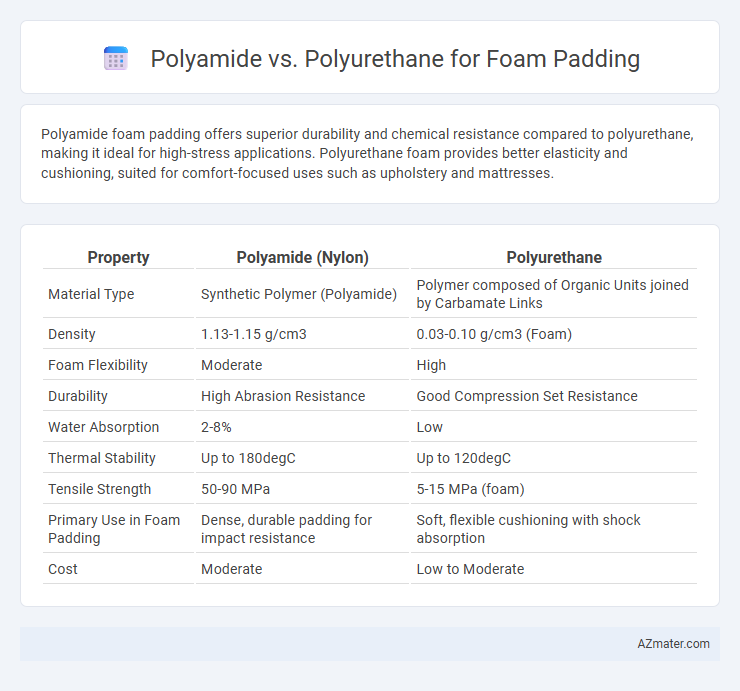Polyamide foam padding offers superior durability and chemical resistance compared to polyurethane, making it ideal for high-stress applications. Polyurethane foam provides better elasticity and cushioning, suited for comfort-focused uses such as upholstery and mattresses.
Table of Comparison
| Property | Polyamide (Nylon) | Polyurethane |
|---|---|---|
| Material Type | Synthetic Polymer (Polyamide) | Polymer composed of Organic Units joined by Carbamate Links |
| Density | 1.13-1.15 g/cm3 | 0.03-0.10 g/cm3 (Foam) |
| Foam Flexibility | Moderate | High |
| Durability | High Abrasion Resistance | Good Compression Set Resistance |
| Water Absorption | 2-8% | Low |
| Thermal Stability | Up to 180degC | Up to 120degC |
| Tensile Strength | 50-90 MPa | 5-15 MPa (foam) |
| Primary Use in Foam Padding | Dense, durable padding for impact resistance | Soft, flexible cushioning with shock absorption |
| Cost | Moderate | Low to Moderate |
Introduction to Polyamide and Polyurethane Foam Padding
Polyamide foam padding, known for its excellent mechanical strength and thermal resistance, is widely used in automotive and industrial applications due to its durability and lightweight properties. Polyurethane foam padding offers superior cushioning, flexibility, and moisture resistance, making it ideal for furniture, bedding, and packaging industries. Both materials provide unique benefits in foam padding, with polyamide excelling in high-performance environments and polyurethane preferred for comfort-focused uses.
Chemical Structure and Composition Differences
Polyamide foam padding features a thermoplastic polymer composed of repeating amide groups, resulting in strong hydrogen bonding that provides high tensile strength and thermal resistance. Polyurethane foam padding consists of polymer chains formed by reacting diisocyanates with polyols, creating a versatile structure with varying rigidity and elasticity depending on the polyol and isocyanate ratios. The distinct chemical compositions influence foam properties: polyamide foams offer superior durability and chemical resistance, while polyurethane foams excel in flexibility and cushioning performance.
Manufacturing Processes Compared
Polyamide foam padding is produced through a polycondensation process that creates a rigid, open-cell structure offering high heat resistance and durability, ideal for automotive and industrial applications. Polyurethane foam padding is manufactured via a polyaddition reaction involving isocyanates and polyols, resulting in a versatile, flexible material with superior cushioning properties widely used in furniture and bedding. Differences in these processes lead to distinct mechanical properties, with polyamide foams emphasizing toughness and thermal stability, whereas polyurethane foams prioritize softness and elasticity.
Physical Properties and Performance
Polyurethane foam offers superior cushioning and flexibility due to its open-cell structure, making it highly resilient and impact-absorbent, while polyamide foam boasts higher tensile strength and durability with better resistance to abrasion and chemicals. Polyamide typically maintains its shape and firmness under prolonged stress and varying temperatures better than polyurethane, which can compress and degrade faster under heavy use. The choice between polyamide and polyurethane foams hinges on performance requirements such as durability, elasticity, moisture resistance, and application-specific physical demands.
Cushioning and Comfort Levels
Polyurethane foam padding offers superior cushioning with its high resilience and ability to quickly regain shape, making it ideal for applications requiring both softness and support. Polyamide foam provides enhanced durability and breathability, maintaining consistent comfort over time with moisture-wicking properties that reduce heat buildup. Choosing between polyamide and polyurethane depends on the desired balance of long-term comfort, cushioning responsiveness, and environmental resistance.
Durability and Lifespan
Polyamide foam padding offers superior durability due to its high abrasion resistance and ability to maintain structural integrity under prolonged stress, making it ideal for long-term applications. Polyurethane foam, while providing excellent cushioning and flexibility, tends to degrade faster when exposed to moisture and UV light, reducing its overall lifespan. Choosing polyamide over polyurethane enhances foam padding longevity, especially in demanding environments requiring consistent performance.
Resistance to Wear, Tear, and Chemicals
Polyamide foam padding exhibits superior resistance to wear and tear due to its high tensile strength and durability, making it ideal for heavy-duty applications. Polyurethane foam offers excellent chemical resistance, effectively withstanding oils, solvents, and many acids, which extends its lifespan in harsh environments. When selecting foam padding, polyamide is preferable for abrasion-heavy uses while polyurethane excels in chemically aggressive conditions.
Environmental Impact and Sustainability
Polyamide foam padding, such as nylon-based foams, typically offers higher durability and recyclability compared to polyurethane, which is derived from petrochemicals with a larger carbon footprint. Polyurethane foam, while popular for cushioning due to its flexibility and cost-effectiveness, often contains toxic additives and degrades into microplastics, raising environmental concerns. Choosing polyamide promotes sustainability through its potential for reuse and lower emissions during production, aligning better with eco-friendly manufacturing practices.
Typical Applications in Industry
Polyamide foam padding is extensively utilized in automotive interiors, sports equipment, and protective gear due to its high durability, excellent thermal resistance, and abrasion resistance. Polyurethane foam finds widespread application in furniture cushioning, bedding, packaging, and insulation panels because of its superior flexibility, cushioning properties, and cost-effectiveness. Industrial sectors often choose polyamide for heavy-duty, high-performance requirements, while polyurethane serves well in comfort-focused and lightweight padding solutions.
Cost Considerations and Market Availability
Polyamide foam padding typically incurs higher manufacturing costs due to its complex polymerization process and superior durability, positioning it as a premium option in the market. Polyurethane foam offers a cost-effective alternative with widespread availability, driven by its simpler production methods and versatile applications across industries. Market trends indicate polyurethane's dominance in volume sales, while polyamide maintains a niche presence where enhanced performance justifies the premium price.

Infographic: Polyamide vs Polyurethane for Foam Padding
 azmater.com
azmater.com